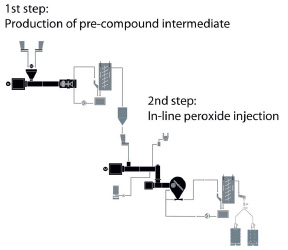Nov 6 2009
For compounding peroxide cross-linkable polyethylene (XLPE) as insulation for high-voltage power cables, the Swiss company Buss AG, Pratteln, has developed an innovative processing system and the operational know-how required. Due to extreme demands on the dielectric strength and durability of insulation, this grade of XLPE must meet exceptionally high purity and quality standards. The new 2-stage system, comprising two BUSS Kneaders, masters this challenge for the following reasons:
- Ultra-fine melt filtration at the end of the first Kneader and
- Strict compliance with the temperature limit for mixing in the peroxide in the second Kneader.

Designed in particular for medium-sized production campaigns, the entire processing line is highly dependable. Furthermore it is compact, above all in comparison with systems using other cross-linking methods. In developing the new system BUSS was able to draw on more than twenty years of active experience with XLPE compounding lines for medium-voltage cable insulation. The first BUSS Kneader in this 2-stage compounding line serves for melting the polyethylene and homogeneously mixing in all additives except the cross-linking agent, such as processing agents, UV and thermal stabilizers as well as fillers. Prior to underwater pelletizing, the compounded material passes through a melt filter with automatic screen changer, which removes all impurities and agglomerates.
The high-purity granulate is then conveyed smoothly and cleanly into the second BUSS Kneader. This Kneader is equipped with a high-precision liquid temperature control system that complies exactly with temperature limits and prevents local overheating. Only after gently heating the granulate to a consistent temperature is the peroxide cross-linking agent injected and homogeneously mixed into the melt. The liquid temperature control system and the unique operating principle of the BUSS Kneader prevent hot spots from forming, so that the XLPE is completely free of pre-crosslinking